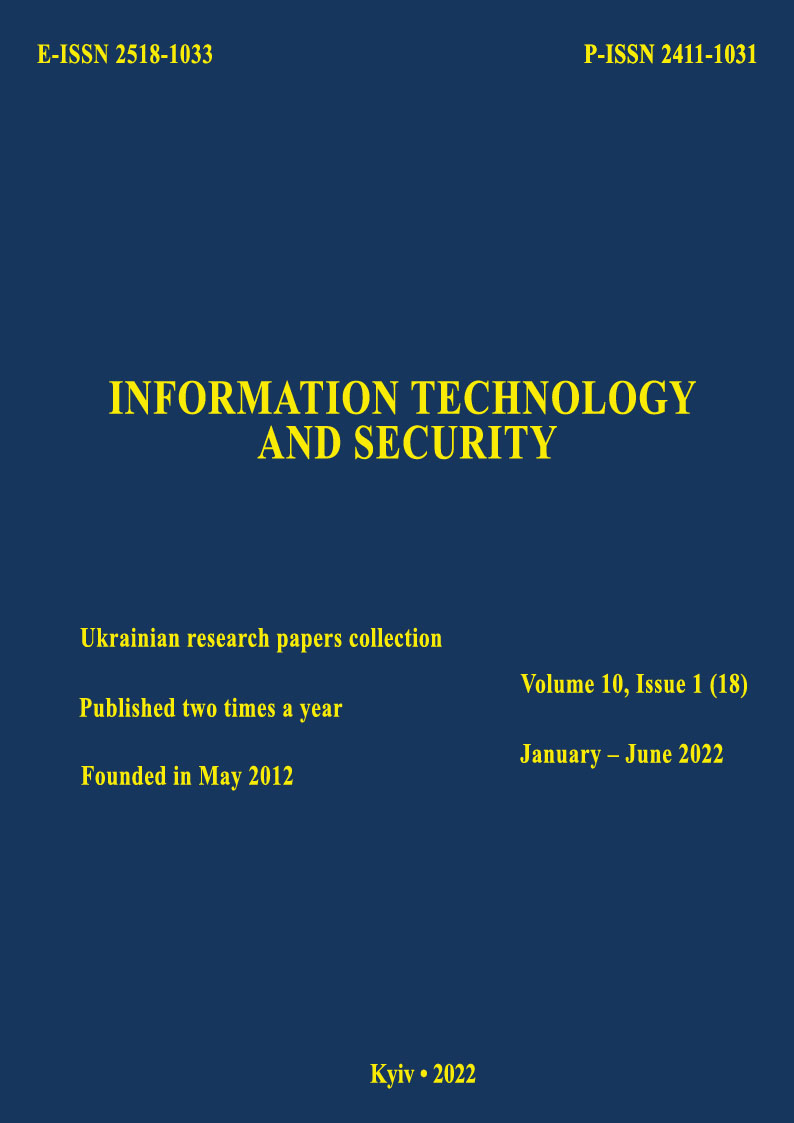Мethod of analysis for analyzing phishing messages
DOI:
https://doi.org/10.20535/2411-1031.2022.10.1.261176Keywords:
phishing, cyber fraud, phishing messages, classification of phishing attacks, method of analysisAbstract
The development and widespread introduction of the Internet into everyday life has transformed both economic and social relations. The representation of these relations in digital form has created a digital economy, characterized by an active exchange of information, quick access to information resources, and the transfer of payments to the digital dimension. Social relations in the digital world are represented by social networks, instant messengers, which also provide economic services. At the same time, the new space, the transformed economy and social relations give rise to new threats. Users themselves actively expose information about themselves and their loved ones, photos of vacations and locations to the public. In addition to social networking, viewing entertainment content and online games, bank settlement transactions are popular. The popularization of Internet banking leads to an increased interest in stealing data from intruders. The result of this is an increase in the number of scammers who aim to obtain confidential user information. In addition, since the beginning of the war, the number of cyber attacks on public authorities, critical information infrastructure facilities and organizations containing critical information has increased. One of the well-known methods of stealing such information is phishing attacks. At the same time, most users underestimate the severity of these attacks and do not pay enough attention to protection systems. This, in turn, leads to wider consequences. Therefore, the problem to be solved is to present a method for analyzing phishing messages that can be used to reduce the probability of reaching the goal of a phishing attack. At the same time, it is known that attackers improve and modify the methods of implementing attacks, and therefore, classifying phishing attacks to increase user awareness is an urgent task. The result of the work is the proposed classification of phishing attacks and the presented method for analyzing phishing messages.
References
Attack on the information front, 2022. [Online]. Available: https://cyberpolice.gov.ua/news/ataka-na-informaczijnomu-fronti---porady-kiberpolicziyi-shhodo-zaxystu-gadzhetiv-vid-vytoku-danyx-6563/. Accessed on: Jan. 3, 2022.
Cyberpolice has stopped the activities of fraudsters, 2022. [Online]. Available: https://cyberpolice.gov.ua/news/u--roczi-kiberpolicziya-prypynyla-diyalnist--onlajn-shaxrayiv-6518/?fbclid=IwAR0RaghjZSzEzytXJ1RARnhVcWEq9IzPKgZIKj3ydsY8QgOaRgqSvEaifl8. Accessed on: Jan. 3, 2022.
Quarterly threat trends & intelligence report November, 2021. [Online]. Available: https://www.phishlabs.com/blog/new-quarterly-threat-trends-intelligence-report-now-available/. Accessed on: Febr. 4, 2022.
S. Dumchikov, and V. Luchikov, “Statistics of phishing incidents in Ukraine in 2021”, 2021. [Online]. Available: https://ir.lib.vntu.edu.ua/bitstream/handle/123456789/34523/91970.pdf?sequence=2&isAllowed=y. Accessed on: Jan. 3, 2022.
PhishTank. [Online]. Available: https://www.phishtank.com/what_is_phishing.php. Accessed on: Jan. 4, 2022.
C. Whittaker, “Large-scale automatic classification of phishing pages”, 2013. [Online]. Available: https://research.google.com/pubs/archive/35580.pdf. Accessed on: Jan. 5, 2022.
Phishing Activity Trends Report, 1st Quarter, 2019. [Online]. Available: http://docs.apwg.org/reports/apwg_trends_report_q1_2019.pdf. Accessed on: Jan. 4, 2022.
M. Akulich, “Phishing and Marketing”, 2022. [Online]. Available: https://books.google.com.ua/books?id=BLsVEAAAQBAJ&printsec=frontcover&hl=ru#v=onepage&q&f=false. Accessed on: Jan. 3, 2022.
What is phishing and how to protect yourself from it. [Online]. Available: https://www.fg.gov.ua/articles/50140-shcho-take-fishing-i-yak-vid-nogo-zahistitis.html. Accessed on: Febr. 3, 2022.
What is spam. [Online]. Available: https://www.eset.com/ua/support/information/entsiklopediya-ugroz/spam/. Accessed on: Febr. 3, 2022.
M. Khonji, Y. Iraqi, аnd A. Jones, “Phishing Detection: A Literature Survey”, IEEE Communications Surveys & Tutorials, vol. 15, no. 4, pp. 2091-2121, 2013. [Online]. Available: https://doi.org/10.1109/surv.2013.032213.00009. Accessed on: Jan. 5, 2022.
I. Yakovyuk, A. Voloshin, and A. Shovkun, “Legal aspects of combating phishing: the experience of the European Union”, Problems of legality, no. 149, pp. 16, 2020.
D. Davydov, “Software for the system of forming filters against phishing on the Internet”. [Online]. Available: http://dspace.kntu.kr.ua/jspui/bitstream/123456789/4088/1/ConferenceMITandCompSysS2013_p89.pdf. Accessed on: Jan. 10, 2022.
O. Boskin, and P. Chorny, “Analysis of the threat of phishing”, in Modern youth in the world of information technology, N. Kirichenko and G. Dimova, Ed. Kherson, Ukraine: Kherson, 2021, pp. 179-181. [Online]. Available: http://dspace.ksau.kherson.ua/bitstream/handle/. Accessed on: Jan. 10, 2022.
O. Boskin, and P. Chorny, “Analysis of protection against phishing”, in Modern youth in the world of information technology, N. Kirichenko and G. Dimova, Ed. Kherson, Ukraine: Kherson, 2021, pp. 182-183. [Online]. Available: https://dspace.ksau.kherson.ua/bitstream/handle/. Accessed on: Jan. 10, 2022.
A. Jain Kumar, “Phishing Detection: Analysis of Visual Similarity Based Approaches”. [Online]. Available: https://www.researchgate.net/publication/312205924_Phishing_Detection_Analysis_of_Visual_Similarity_Based_Approaches. Accessed on: Febr. 4, 2022.
D. Gupta, “Comparison of classification algorithms to detect phishing web pages using feature selection and extraction”. [Online]. Available: https://pdfs.semanticscholar.org/fccd/8ff23734a1947d3efc14d3df9863a5efac6c.pdf. Accessed on: Jan. 4, 2022.
Anatomy of phishing, 2020. [Online]. Available: https://blog.avast.com/ru/the-anatomy-of-a-phish-avast. Accessed on: Jan. 10, 2022.
All about phishing. [Online]. Available: https://ru.malwarebytes.com/phishing/. Accessed on: Jan. 10, 2022.
Do-it-yourself Phishing, 2017. [Online]. Available: https://habr.com/ru/company/aktiv-company/blog/329470/. Accessed on: Jan. 9, 2022.
T. Dakpa, “Study of Phishing Attacks and Preventions”, International Journal of Computer Applications, vol. 163, no. 2, pp. 5-8, 2017. [Online]. Available: https://www.ijcaonline.org/archives/volume163/number2/dakpa-2017-ijca-913461.pdf. Accessed on: Jan.14, 2022.
Downloads
Published
How to Cite
Issue
Section
License
Copyright (c) 2022 Collection "Information Technology and Security"

This work is licensed under a Creative Commons Attribution 4.0 International License.
The authors that are published in this collection, agree to the following terms:
- The authors reserve the right to authorship of their work and pass the collection right of first publication this work is licensed under the Creative Commons Attribution License, which allows others to freely distribute the published work with the obligatory reference to the authors of the original work and the first publication of the work in this collection.
- The authors have the right to conclude an agreement on exclusive distribution of the work in the form in which it was published this anthology (for example, to place the work in a digital repository institution or to publish in the structure of the monograph), provided that references to the first publication of the work in this collection.
- Policy of the journal allows and encourages the placement of authors on the Internet (for example, in storage facilities or on personal web sites) the manuscript of the work, prior to the submission of the manuscript to the editor, and during its editorial processing, as it contributes to productive scientific discussion and positive effect on the efficiency and dynamics of citations of published work (see The Effect of Open Access).

